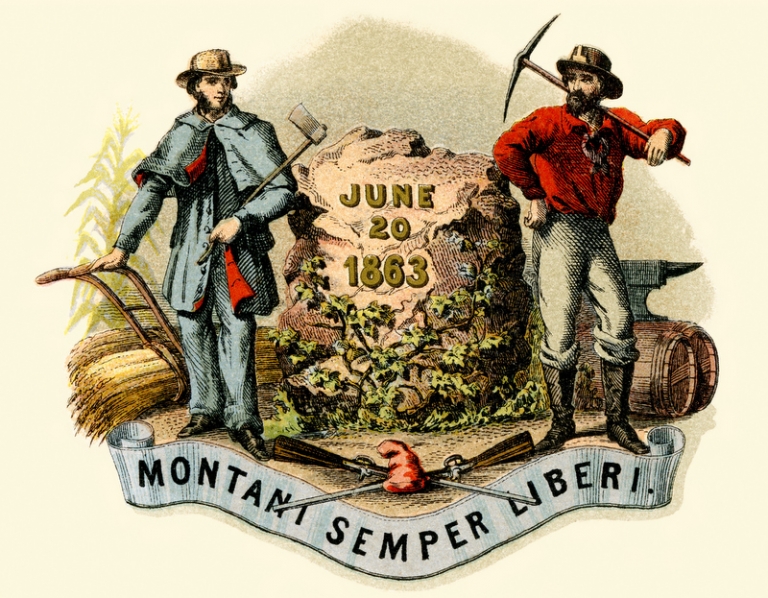
CHARLESTON, W.Va. — The Great Seal of West Virginia may be as fascinating to some West Virginians as the U.S. dollar bill is for other Americans. It's full of symbolism, the origins of which continue to be examined. Some of its symbols are mysterious, while others are likely more obvious.
What is a state seal? A seal is a device designed to authenticate a document, usually a legal document. In this case, it's an official state document. A seal-making device, or die, creates an impression in wax or some other medium, including an embossment on paper.
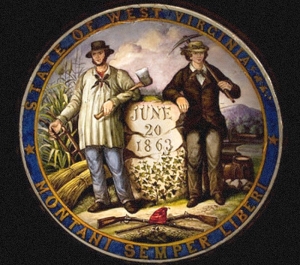
According to state law, all public documents and state papers must be affixed with the seal before they become official. In this case, custody of the Great Seal, and the "Less Seal," which is simply a smaller version of the Great Seal, is given to the Secretary of State, and he or she is responsible for affixing them to official documents.
On the second day of the first session of the West Virginia Legislature, in June 1863, Peter G. Van Winkle, a member of the House of Delegates from Parkersburg, representing Wood County, offered Joint Resolution No. 2, which read:
"Resolved, with the concurrence of the Senate, that a committee be appointed to devise and report suitable devices and inscriptions for the seals of the State and report the same to the Legislature; and that until such seals are adopted and ready for use the Governor be authorized to affix his private seal to all instruments otherwise requiring the seal of the State."
On the previous day, the Legislature had adopted a resolution calling for the use of a seal on official papers. A committee was duly appointed, consisting of Van Winkle and L. E. Davidson, of Taylor County, Edwin Maxwell, of Harrison County, and Greenbury Slack, of Kanawha County.
Its members settled on the various motifs desired in the seal and presented them to Joseph H. Diss DeBar, a French artist and land agent who had immigrated to the U.S. and settled in Doddridge County. DeBar afterward became the state's Commissioner of Immigration.
The design and description which the committee provided DeBar was adopted by the Legislature on September 26, 1863. The seal was designed with two sides, so it could be made as a medallion, and for many years both sides were used on all official documents, though the reverse was discontinued, and no dies of it are in existence. Their last use may have been in the 1920s. In 1939, Judge William S. O'Brien, then Secretary of State, ventured the opinion that the dies were destroyed in a fire that consumed the temporary capitol office building in Charleston in 1927.
The design was sometimes varied somewhat since it was first employed, according to historian Jim Comstock, who in his West Virginia Heritage Encylopedia recorded that the seal's design had been changed on occasion.
"Apparently an artist who was engaged to prepare new dies to replace those which had been worn made some modifications," he said, "changing the position of the coal miner, making the center rock higher, and engraving the date on the rock with different lettering." During the administration of Secretary of State O'Brien, Comstock said, the Board of Public Works passed a resolution authorizing O'Brien to recall these "spurious seals" and have new ones prepared according to the original design.
Imagery in the State Seal of West Virginia
Most details of the design have remained through the years according to the specifications outlined by VanWinkle and the Legislative committee. These are the familiar configurations of the seal's obverse, used on state documents, the state flag, and on stationery of government officials. The specifications were as follows:
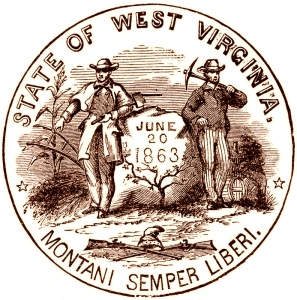
"The disc of the Great Seal is to be two-and-one-half inches in diameter; the obverse to bear the legend 'The State of West Virginia,' the constitutional designation of our Republic, which with the motto, Montani Semper Liberi—"Mountaineers always free"—is to be inserted in the circumference. In the center, a rock with ivy, emblematic of stability and continuance, and on the face of the rock the inscription, 'June 20, 1863,' the date of our foundation, as if graven with a pen of iron in the rock forever.
"On the right of the rock, a farmer clothed in the traditional hunting garb, peculiar to this region, his right arm resting on the plow handles, and his left supporting a woodman's axe, indicating that while our territory is partly cultivated, it is still in the process of being cleared of the original forest. At his right hand, a sheaf of wheat and a cornstalk.
"On the left hand of the rock, a miner, indicated by a pick-axe on his shoulder, with barrels and lumps of mineral at his feet. On his left, an anvil, partly seen, on which rests a sledgehammer, typical of the mechanic arts, the whole indicating the principal pursuits and resources of the state.
"In front of the rock and the hunter, as if just laid down by the latter and ready to be resumed at a moment's notice, two hunters' rifles, crossed and surmounted at the place of contact by the Phrygian cap, or cap of liberty, indicating that our freedom and liberty were won and will be maintained by the force of arms.
"The reverse of the Great Seal is to be encircled by a wreath composed of laurel and oak leaves, emblematical of valor and strength, with fruits and cereals, productions of the State. For device, a landscape. In the distance, on the left of the disc, a wooded mountain, and on the right a cultivated slope with the log farmhouse peculiar to this region. On the side of the mountain, a representation of the viaduct on the line of the Baltimore & Ohio Railroad in Preston County, one of the great engineering triumphs of the age, with a train of cars about to pass over it.
"Near the center a factory, in front of which a river with boats, on the bank and to the right of it nearer the foreground, a derrick, and a shed, appertaining to the production of salt and petroleum. In the foreground a meadow with cattle and sheep feeding and reposing, the whole indicating the leading characteristics, productions, and pursuits of the State at this time.
"Above the mountain, etc., the sun emerging from the clouds, indicating that former obstacles to our prosperity are now disappearing. In the rays of the sun the motto Libertas et Fidelitate—Freedom and Loyalty—indicating that our liberty and independence are the result of faithfulness to the Declaration and the National Constitution. The committee further recommend that the above device and motto, for the obverse of the Great Seal be also adopted as the Coat-of-Arms of the State."
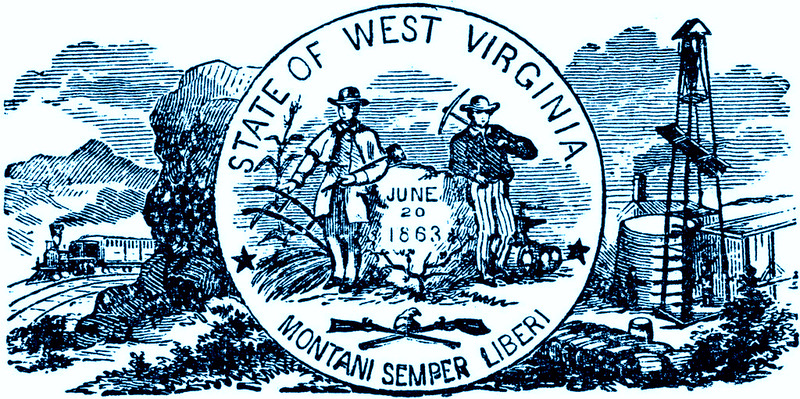
Mysteries of the West Virginia State Seal
In addition to the specifications of the seal cited above, observant folks over time have spotted details that they found remarkable. Is there a significance to its many symbols? Especially as regards the lesser-known obverse of the seal, some meanings have been questioned with more than usual keenness.
Is there meaning in the numbers of mountains represented in the obverse seal, in the number or placement of cattle or the kinds of plants represented? The art and study of representation through symbols is known as semiotics.
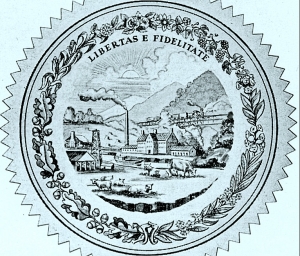
Among the most discussed mysteries of the seal is the existence of a keg, or kegs, represented beneath an anvil alongside the miner. No specifications for their inclusion were provided by the committee, and DeBar apparently never left any explanation, which gave rise to speculation on that account. Comstock in his encyclopedia printed a letter penned by Ella D. Haller, of Sutton in 1962. Haller supposed
"All old-timers born 75 to 80 years ago became familiar with the powder keg in the general store, where gunpowder was sold by the ounce or cow-horn full as might be convenient. Also, iron was mined in W.Va. that long ago.
"I was born near Savagetown, now Strange Creek, where the Savage brothers had a smelter. They produced boatloads of iron 'pigs' that went to Charleston and other places beyond and came back to our neighborhood as kegs of cut nails, which at first drew criticism as a new-fangled invention that was taking the place of the old, reliable, square hickory pegs in various sizes of round auger holes that was used to anchor planks and framework of houses in place. It was prophesied that these nails would soon rust out and let our houses collapse. This idea had more truth than fiction, as many an old English castle will verify that was pinned up hundreds of years ago.
"If nails and gunpowder are incorrect as the kegs' or barrels' contents, then there was the universal, as far as W.Va. was concerned, barrel of salt, which was part of the annual buy for any farm home, and did or did not W.Va. mine salt? Whether coal tar was or was not produced by the barrel in W.Va. at the time of the Seal's birth, I do not know; but there was rosin and flour, and maple sugar—and other sugar, mostly brown—came to hand in barrels; and there was the indispensable 'lasses barrel, hand-made from the finest maple or poplar staves, with perfect smoothness and holding from 25 to 50 gallons, according to family capacity; there were others for lye soap, for kraut, for pickles, cider, and vinegar. And in the stores, barrels of horseshoes, plow-points and dozens of other articles, including shoes with neither rights or lefts. All-in-all, so many uses for barrels, besides the 'porkbarrel,' abounded in W.Va. that it is not strange to find it incorporated into the State Seal. My guess for kegs is gunpowder and cut nails; for barrels; salt and kerosene."
Civil War-era mystery of Burning Springs remains unsolved
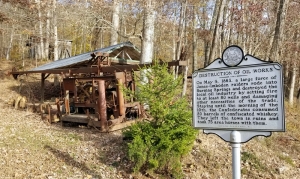
Curious motorists traveling the valley of the Little Kanawha southwest of Parkersburg may or may not stop at Burning Springs. Here a defunct country museum filled with oil-drilling paraphernalia is at least likely to cause curious travelers to slow down, but there's a strange and heroic history behind its great mystery. Read the full story here.
Sign up to receive a FREE copy of West Virginia Explorer Magazine in your email weekly. Sign me up!




























